on EV Work Trucks, Diesels, the New Range Rover, Stamping, Stylish Sustainability, & Thor
The VW ID. Buzz is more than cool. . .diesels aren’t particularly popular in the U.S. but Europe is different. . .the New Range Rover reviewed. . .GM spends on stamping. . .the potential autonomous future. . .Conti’s sensor suite. . .IAC creates a green gown. . .NVIDIA announces Thor. . .
Working for a Living: ID. Buzz
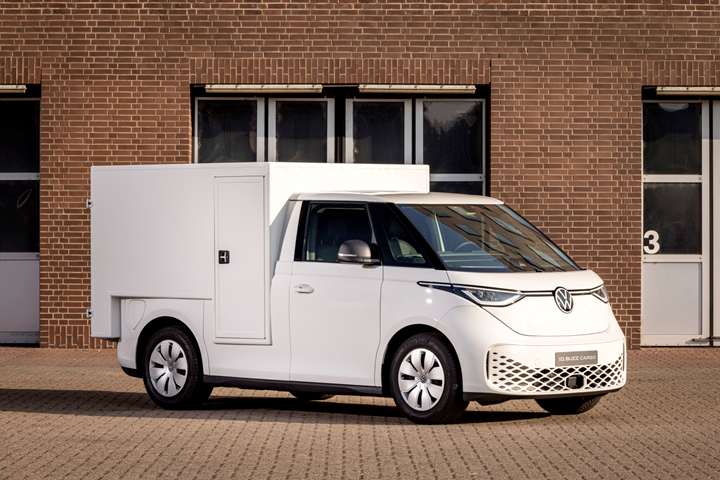
A near-production VW ID. Buzz with cargo capability in the back. (Image: VW Commercial Vehicles)
Arguably, plenty of American EV enthusiasts are waiting to get behind the wheel of a VW ID. Buzz, the 21st century re-imagining of the Microbus, they’re going to have to wait for about a couple more years.
From school driveways to surfing spots, the ID. Buzz will undoubtedly become a fixture.
Meanwhile, over in Germany, not only is the vehicle available, but Volkswagen has had upfitters create special versions of the vehicle to show its capabilities.
Here’s something to know about that: the ID. Buzz and the ID. Buzz Cargo are being produced by Volkswagen Commercial Vehicles, so the near-production concept vehicles created for display at the IAA Transportation 2022 show are not for taking the kids to camp but for vocational applications.
- Snoeks, a Dutch commercial upfitter, has modified an ID. Buzz Cargo for the transport of people or goods. It is described as being “the perfect vehicle for the manual trades.”
- Bösenberg, a German upfitter, has created a version for paramedics.
- Veth Automotive, out of the Netherlands, has completely changed the profile of the ID. Buzz by adding a box superstructure. This increases the cargo capacity from 3.9 cubic meters to 6 cubic meters. What’s more, the configuration lends itself to the addition of various types of doors and sliding shutters.
- Wükaro, a German upfitter that specializes in refrigeration, has installed an electric cooling system with a 230-V cooling unit on the roof, four lithium-ion batteries housed in the wheel arches, and an inverter with an integrated battery charger.
- CS/Würth and Volkswagen Commercial Vehicles worked together on a service van for appliance manufacturer Miele. Shelving units, a center console with an integrated folding table, and other features are installed.
While those vans all have commercial signage on their exteriors, one imagines that when the ID. Buzz comes to America, if anything, the exteriors will be adorned with a blossoming of paisley and swirls. . . .
///
Diesel Leaving Ram; Continuing in Europe
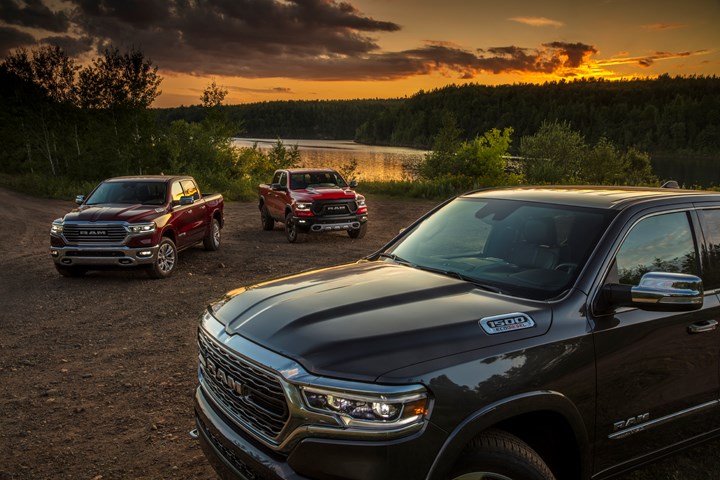
The sun is setting on Ram 1500 diesels. (Image: Ram)
Back in 2014 Ram brand offered a 3.0-liter V6 EcoDiesel engine in the Ram 1500 half-ton full-size pickup. The truck received a 28-mpg rating from the EPA, then said to be the best highway-cycle test result ever by a half-ton pickup.
In the first 72 hours the truck was on sale more than 8,000 were sold.
Ram has been offering the Ram 1500 EcoDiesel since. . . but last week the company announced that come January 2023, the diesel will go out of production.
Going Electric
Mike Koval Jr., Ram brand CEO-Stellantis, said, “As we quickly pivot toward an electrified future, we wanted to celebrate this last EcoDiesel milestone by offering our loyal light-duty diesel enthusiasts a final opportunity to order the truck they love.”
Said another way: Better get one while you can.
Come 2024 there will be a battery electric 1500.
Euros & Diesels
This commitment to electrification on the part of Ram—it intends to have offerings in all of its segments by 2030—is particularly interesting in contrast with recent numbers regarding the diesel light vehicle market in western Europe from LMC Automotive.
While there has been a decline of diesel sales from January to August ’22, LMC found that there was a year-over-year increase in sales in August, with Germany, Austria, Portugal and Switzerland all showing gains.
In Germany the increase was some 4,000 vehicles.
(Not that they’re not buying EVs. But they’re still buying diesels.)
Notably, LMC found that about 40% of the diesel vehicles sold in western Europe have premium badges. In January to August timeframe Mercedes has sold 170,000 diesel passenger vehicles, followed by BMW at 150,000.
In the mainstream segment, Volkswagen has sold 195,000 and Peugeot 140,000.
Given that all of those companies are promoting their electric offerings, somehow this seems a bit off-brand.
///
2022 Range Rover First Edition SWB

The house may be angular but the body forms on the New Range Rover are sleek, smooth and sophisticated. (Image: Jaguar Land Rover)
It so happened that I had the 2022 Range Rover First Edition SWB the week that Queen Elizabeth II died.
Speaking of this, the fifth generation of Land Rover’s luxury SUV, Gerry McGovern, Chief Creative Officer, Jaguar Land Rover—who was made an Officer of the Order of the British Empire (OBE) during the 2020 New Year Honours—said:
“The New Range Rover is a vehicle with a peerless character, from the impeccable restraint of its exterior to the flawless tranquil sanctuary of its cabin. Informed by creative intellect and a desire for perfection, it doesn’t follow fashion or trend, but by a modernist design philosophy, combined with over 50 years of evolution, it is quite simply the most desirable Range Rover ever created.”
Which, with all due respect, brings the late Queen to mind.
Solid & Flexible
The New Range Rover (yes, they capitalize “new”) is based on a new body architecture, MLA-Flex, with the letters standing for “modular longitudinal architecture). The “Flex” comes into play in that there are two wheelbases The standard has a length of 199 inches, a width of 87, height of 73.6 and wheelbase of 118 inches. The long adds 8 inches to the overall length.
Flex must also manage an array of powertrain offerings, from the V8 in the vehicle as-driven to a future full battery electric model.
One of the reasons why the architecture—which involves such things the extensive use of high-strength steels to create rings around the A-, C- and D-pillars and another around the front door opening—is notable is because the engineers wanted to create as torsionally stiff structure as possible not only because this vehicle is something that can be taken off-road (anyone who takes one of these rolling sculptures off road really must be like King George III in his later years) but, more importantly, to make the cabin cosseted-quiet. (To add assurance: there is an active noise cancelation system that utilizes 35 speakers from the 1,600-W Meridian Signature Sound System.)
Inside & Out
There are really two parts to this vehicle: the inside and the outside. (While this might seem fairly obvious, there would also be a potential segmentation dealing with aspects of the powertrain, the driver assistance tech, etc.)
On the inside, no surprise, there are a select arrangement of materials from plated metals to smooth leathers. It is well executed.
Being the 21st century there is obligatory tech, such as the “Pivi Pro” infotainment system that is accessed through a 13.1-inch touch screen.
For those in the back there are 11.4-inch touchscreens mounted on the seat backs of the front seats.
Although the Brits put the first large-scale computer into operation in 1944 so the code-breakers at Bletchley Park could get a leg up, let’s put it this way: You probably don’t know anyone who owns a British computer, even if you live in London.
I was impressed by the materials in the Range Rover.
The tech. . .well, I’ll simply be discrete and leave it at that.
However, the exterior of the vehicle is something to behold. The workmanship on the sheet metal is nothing short of superb. There are curved, smooth surfaces aborning. While no one is going to know how they did it, they used a laser to combine the roof with the bodyside so that it, too, is in keeping with the overall silky surface.
(The vehicle as-driven had an optional Sunset Gold Satin Finish, and while that is a $7,450 upcharge, that is really worth it because the MSRP is $158,200 so what the hay, as they may say in the environs of Coventry.)
If there is a desirable finish, there it is.
Time & a Word
Which brings me back to the beginning.
Post Elizabeth II there is some question about the monarchy, as in will its importance diminish during the reign of Charles III, and certainly when Prince William ascends the throne?
People wonder.
Land Rover sales in the U.S. were 17,285 in 2021, up from the 13,982 of 2020, but down from the 18,831 of 2019.
It is a special vehicle. Not a mass market vehicle.
But I wonder about things like the technology. Those buying SUVs from places like Ulsan and Detroit and Tahara can get arguably better tech in their vehicles. Does that matter to a prospective Range Rover customer?
I wonder about the 523-hp twin turbo V8.
V8.
Yes, Land Rover will be putting in hybrids and even an EV propulsion system, but isn’t a V8 something of an anachronism for the New Range Rover?
It probably doesn’t matter.
Those who are going to buy this SUV are not going to cross shop it with anything that doesn’t have a pedigree.
Were you to look at the Land Rover International home page on September 19 you would see a black box at the top of the page with a picture of Elizabeth II and the text:
The passing of Her Majesty The Queen has left everybody at Jaguar Land Rover deeply saddened, and our thoughts and condolences remain with the Royal Family today as Queen Elizabeth II is laid to rest.
We are truly grateful for the countless happy memories created from our long-standing relationship with the Royal Family. We shall deeply miss Her Majesty’s pioneering leadership and strength.
Our relationship with The Queen will forever be a source of great pride for everyone at Jaguar Land Rover and we are incredibly honoured to be fulfilling our duty to Her Majesty on what will be an enormously sad day for the nation and for the Commonwealth.
You buy the New Range Rover because you can. And because you know that it represents something more than just an SUV.
///
Money for Stamping
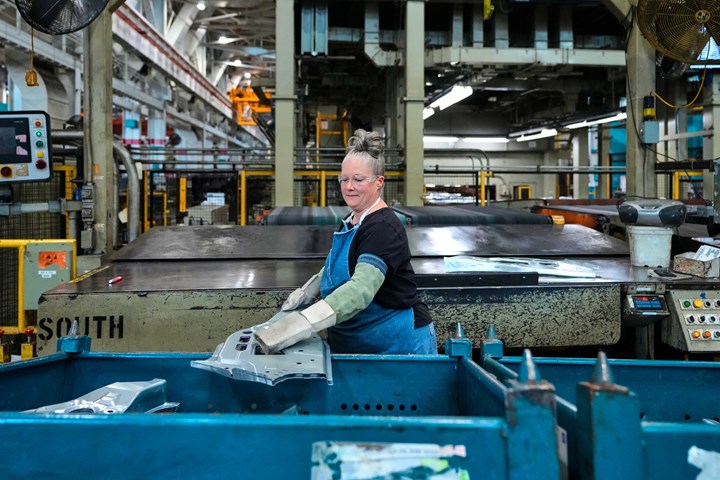
EVs need more than batteries. Like stamped parts. (Image: GM)
It seems as though there is an endless number of announcements regarding investments in battery plants.
What doesn’t seem to get the same amount of attention is the fact that those batteries have to go into things. Like vehicles.
So it is interesting to note that GM announced a $491-million investment in its Marion Metal Center in Indiana.
The monies will be used for:
- Two new press lines
- Upgrading of existing equipment and tooling
- Constructing a ~6,000-square foot addition
When announcing this, Gerald Johnson, GM executive vice president of Global Manufacturing and Sustainability, said, “While this investment prepares the facility for our all-electric future, it’s really an investment in our talented Marion team and will keep the plant working for many years to come.”
So what do they do at Marion?
They stamp an array of exterior and structural components—fenders, floor pans, plenums and more.
While they are currently processing just steel, with the two new presses and the refurbishment of two more, they’ll have both steel and aluminum stamping capability.
While Johnson gave the nod to EVs, at Marion they’re making parts for important GM vehicles.
As in:
- Tailgate inners and outers, front and rear underbody floor pans, and the front dash for the Colorado and Canyon pickups
- Outer body sides, front fenders, front dash, inner and outer box panels, rear inner wheel-house panels, and front box panel for the Silverado and Sierra pickups
While there will be work for EVs, let’s face it: body panels and support members are fairly indifferent to propulsion systems.
///
Driving Then, Now & the Future
In 2004 a new Jeep Grand Cherokee (WK) was introduced. As were the fifth-generation Mustang and the Chevy Equinox.
In other words, what was happening 18 years ago doesn’t seem to be all that different than what is happening now.
Last week Jeep announced the 30th anniversary edition of the Grand Cherokee, but this one a hybrid unlike the first one (ZJ).
The seventh-generation Mustang was also unveiled last week.
And the 2024 Equinox EV was announced the week before that.
Different. But the same.
The Future
Eighteen years from now will be 2040.
A new report from BloombergNEF predicts that by 2040 approximately 8% of all miles traveled by passenger vehicles will be autonomous.
That is a global estimate.
Know that in 2022 the U.S. Dept. of Energy projects that Americans will drive 3.26 trillion miles. Eight percent of that is 2.6 billion miles. And this is just in the U.S.
One wonders. . .2004 in auto was not all that different from 2022.
So will there be a step change by 2040?
///
The Import of Interchangeability
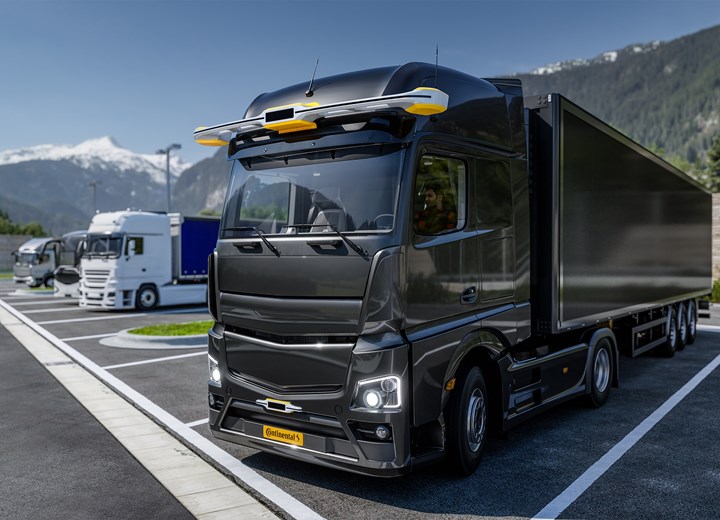
Continental has developed a sensor array that is essentially plug-and-play. (Image: Continental)
When things get to the point in their development that they are interchangeable (yes, as in Eli Whitney’s “interchangeable parts”), they are products, not projects.
Speaking of the multi-sensor system developed for applications in commercial vehicles, Dr. Andree Hohm, Head of Innovation Line Driverless Autonomous Mobility Business Area at Continental, said, “Radar, lidar and cameras are pre-calibrated and matched to each other. The effort for the final calibration of the sensor solution during assembly, the effort for the assembly of the sensor systems themselves and, finally, for the maintenance of the vehicles is significantly reduced. When trucks drive autonomously and are on the road around the clock, our sensor array can be easily replaced for maintenance work, for example. In this way, costly downtimes can be avoided.”
Interchangeable.
Although Claudia Fründt, Head of Market Trucks Autonomous Mobility Business Area at Continental, describes the Continental Sensor Array as being “a “tailor-made system,” she also says, “Our solution offers uncomplicated assembly and calibration of multiple sensor systems in a single, compact module.”
The system is designed to fitted in existing trucks (assuming the electrical system is up to accommodating it) as well as future vehicles, without modification to the driver’s cab. It is mounted above the windshield.
Sensor pre-calibration and coordination in a packaged system can certainly facilitate levels of automated driving for commercial vehicles.
Productization matters.
///
Stylish & Sustainable
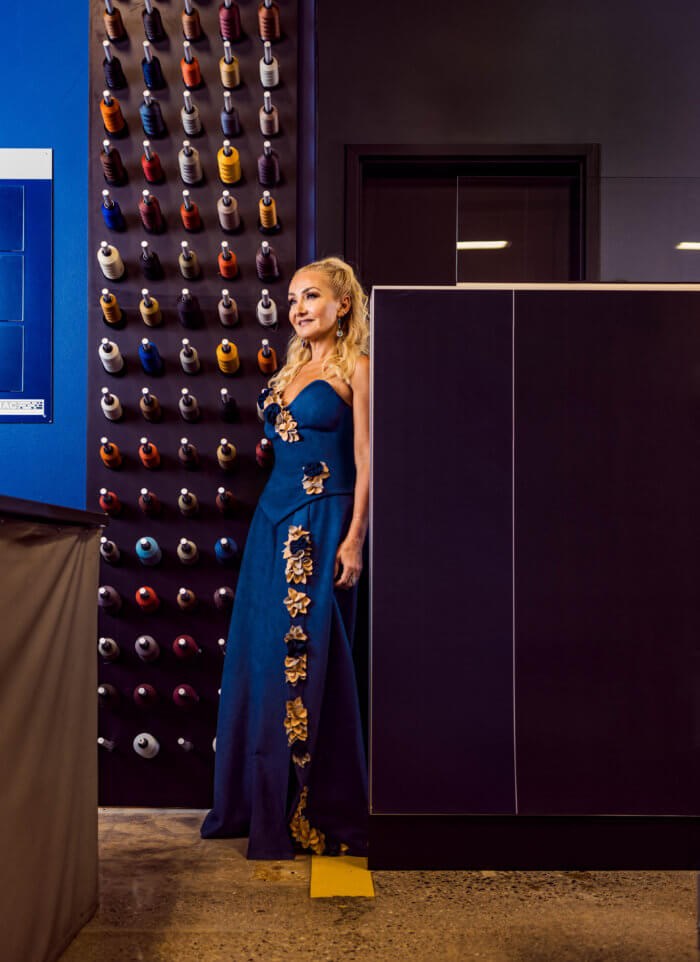
IAC Chief Administrative Officer Iwona Villaire in the gown she helped create. It is made primarily from the types of environmental materials IAC uses on auto interiors. (Image: IAC)
Last week both the North American International Auto Show (NAIAS) in Detroit and Fashion Week in New York commenced.
So a team at International Automotive Components Group (IAC)—a supplier of products including instrument panels, console systems, door panels, headliners and overhead systems—took inspiration from the on-goings in New York and created a gown designed and worn by IAC Chief Administrative Officer Iwona Villaire at the NAIAS Charity preview—a gown made with sustainable materials IAC uses in automotive applications.
There are:
- Dinamica, a microfiber partially made from recycled polyester. IAC uses it for things including headliners and door bolsters. It makes up the body of the gown.
- Cork coverstock and laser wood coverstock. Both of these materials are plant-based and used in applications rather than materials including PVC and TPO. They are used for the flower appliques on the gown.
- Plastic recycled from discarded polypropylene fishing nets are used for the jewelry, as is mold-in color plastic, which doesn’t use any paint or film and thereby is more readily recyclable.
The materials were selected by IAC’s Susan Kozora, director of advanced engineering and Michael Behnke, director, innovation & advanced technology in Europe.
Villaire’s sketch and the selected materials were turned over to Urszula Olkiewicz, junior trim engineer at IAC Group’s Opole, Poland facility, who developed the gown. Then Olena Korolova, sewing production operator brought it all together.
Villaire:
“This gown exhibits the collective skills, expertise and attention to detail our teams at IAC Group have for each and every product we touch. Our seamstresses are on par with those whose work is dawning the runways of New York this week for Fashion Week.”
///
Driven, Defined
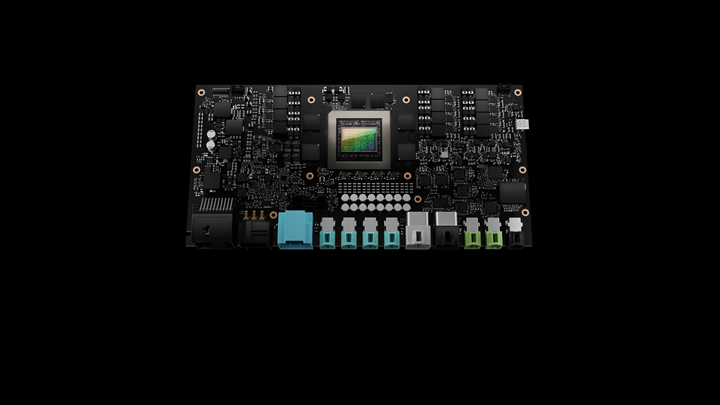
NVIDIA Thor. See those connectors along the bottom? Plug in everything from ADAS to IVI. (Image: NVIDIA)
Last year NVIDIA announced NVIDIA DRIVE Atlan, a processing platform for automotive applications capable of running 1,000 trillion operations per second. This was a 4x gain over its previous generation. Plans were to have it out for sampling next year, with application in production vehicles in 2025.
Earlier this week NVIDIA announced NVIDIA DRIVE Thor. It offers up to 2,000 teraflops of performance—double the Atlan.
And although Atlan hasn’t hit the streets, Thor has replaced it.
Clearly the people at NVIDIA are driven.
When have you heard of a company announcing a product that has more performance than its own previously announced but yet-to-be released product?
Integration
Danny Shapiro, NVIDIA’s vp of Automotive, describes Thor as a “superchip.”
He notes, for instance, that it is configured so that what might otherwise be independent ECUs are integrated into Thor. This means that whether it is sensors for automated and assisted driving functions or occupant monitoring, whether it is powering the digital instrument cluster or serving up the in-vehicle infotainment, Thor can handle it.
Shapiro says that this integrated capability allows a lower total system cost, as factors ranging from energy to consolidation and connections are addressed.
Neural Net Enhancement
One notable feature of Thor is an inference transformer engine. This is important because it boosts the performance of deep neural networks by up to 9x—and as self-driving involves massive and complex AI workloads, faster is better.
You’ve heard of the “software-defined vehicle,” something that can be updated and upgraded through over-the-air updates?
This is something that can allow that to happen. And then some.
Thor will not only be available in production volumes in 2025, but Chinese OEM ZEEKR will be putting it into production vehicles that year.
They’re evidently driven, too.
RELATED CONTENT
-
Cobots: 14 Things You Need to Know
What jobs do cobots do well? How is a cobot programmed? What’s the ROI? We asked these questions and more to four of the leading suppliers of cobots.
-
Ford Copies Nature
As Nature (yes, capital N Nature) has done a pretty good job of designing things, it is somewhat surprising that Man (ditto) doesn’t follow Nature’s lead more often when it comes to designing objects.
-
When Automated Production Turning is the Low-Cost Option
For the right parts, or families of parts, an automated CNC turning cell is simply the least expensive way to produce high-quality parts. Here’s why.


.jpg;width=70;height=70;mode=crop)






